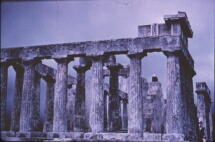View My Guestbook
Sign My Guestbook
E-mail
|
|


Sculpture ||
Architecture ||
Wall Paintings
Sculpture
Unlike the Greeks, the Romans preferred Verism to Idealism. Verism
is the realistic portrayal of actual people. The Greeks during the
Classical period focused primarily on athletes and gods, showing them in
idealistic bodies (even as they are fighting or dying). The Romans
however, preferred to show their senators with wrinkles, baldness, and
pot-bellies. To the Romans, age showed wisdom, and thus many politicians
preferred to be depicted as old and wise.
 |
The Romans also made death masks. That is, they put wax over the
face of someone who just died to make a bust of. Romans
practiced ancestor worship with these death masks. |
| That is not to say the Romans did not like Greek sculpture. Most
of our knowledge of Greek statues comes from Roman replicas. The
Greeks preferred to work in bronze so most of their statues were melted
down over the centuries. The Romans preferred marble, so many of their
sculptures survive. This statue of Genetrix for example is only known in its Roman copies. |  |
Architecture
 | The Romans were the inventors of concrete, a cheap solid building material.
It was harder than the terra cotta used by the Etruscans, and less expensive
than the marble used by the Greeks. They used much of concrete in their
construction. Concrete, however, is not as attractive as marble in appearance
so the Romans often constructed a building in concrete and then put a marble
facade over it. |
| The Romans were also the inventors of the dome and made exclusive use
of arches. The Greeks knew about the arch but never used it in their
construction. The Romans utilized the arch in their aqueducts throughout the Roman Empire, as well as the famous Colosseum. The dome is used in the
Pantheon. To lighten the weight of the dome itself, the ceiling
is coffered. There is an oculus on the top of the Pantheon which opens
to the sky. The ground is slightly elevated so the rain would not
gather in the center. It is quite an architectural feat. |  |
 | In terms of temples, the Romans combined the influences of both the
Greeks and the Etruscans. Unlike the Greeks, the Romans temples can
only be entered in one side, like the Etruscan temples. However,
in both Greek and Roman temples, only one deity is worshipped,
where as there are three deities in an Etruscan temple. |
| The best
example of the Roman combining Greek and Etruscan is the engaged columns.
The Greek temple is surrounded by a peristyle (columns on all four sides),
while the Etruscan temples only have columns in the front. In some
Roman temples, actual columns (those that gives structural support) are
placed in the front while engaged columns surround the rest of the temple. The Romans preferred Corinthian columns instead of the Doric columns which the Greeks liked better. The Greeks thought the Corinthian columns were too feminine. |  |
Wall Painting
 |
Because of volcanic ashes sealed off air, much of the wall paintings
remain in Pompeii. In the Odyssey Landscapes, we see
one of the first examples of continuous narratives. The Greeks sometimes
used narratives on their friezes, but you will never see the same person on
the same panel. Continuous Narrative on the other hand shows the
same person on several different panels (like a comic book). Another
place that uses this form of narrative is in the Villa of Mysteries, where
a Bacchi/Dionysis (god of wine) initiation ceremony is taking place.
In this scene, although the initiate is seen over and over, your eyes only
allow you to see one of her images at a time. |
Romans also used wall painting to make their rooms seem more spacious.
Their painting shows beginnings of perspectives, but they have not perfected it
Sculpture ||
Architecture ||
Wall Paintings
|








